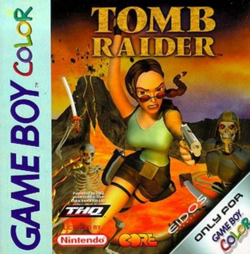Software:Tomb Raider (Game Boy Color video game)
| Tomb Raider | |
|---|---|
 European box art | |
| Developer(s) | Core Design |
| Publisher(s) | THQ |
| Producer(s) | Troy Horton |
| Designer(s) | Darren Price |
| Artist(s) | Matthew Charlesworth |
| Composer(s) | Manfred Linzner Bernhard Wodok |
| Series | Tomb Raider |
| Platform(s) | Game Boy Color |
| Release | |
| Genre(s) | Action-adventure |
| Mode(s) | Single-player |
Tomb Raider is a 2000 action-adventure video game developed by Core Design and published by THQ for the Game Boy Color under license from series owner Eidos Interactive. Following series protagonist Lara Croft as she searches ruins in South America for a powerful artefact, the gameplay features platforming and puzzle-solving on a 2D side-scrolling environment.
Tomb Raider was the debut entry for the series on Nintendo platforms, with it being described by developers and journalists as technically impressive for the platform. It sold well for THQ, and was praised by critics for its technical achievements and emulation of the main series gameplay in portable form. Two sequels were released; Curse of the Sword in 2001, and The Prophecy in 2003.
Gameplay
In Tomb Raider, the player control Lara Croft though 14 levels spread across five areas.[1] In each level, the player must solve puzzles, jump over obstacles, and defeat enemies. Lara can perform up to 25 different moves, including ledge-grabbing, backflips, and cliff-diving.[2] The story of the game follows Lara's attempts to stop a group of treasure hunters from possessing the Nightmare Stone, a key capable of releasing the evil god Quaxet.[1]
Development and release
Tomb Raider was developed for the Game Boy Color (GBC) by series creators Core Design as the character's first title on Nintendo hardware. Eidos Interactive producer Mike Shmitt described the game as technically impressive for the platform given the character's origins on more powerful hardware. Lara's animations, numbering over two thousand, were rendered from the home console originals, with direct memory access used to make the animations work. Lara's model was 48 pixels, far more than other player characters on the console.[3] The music and audio were handled by Manfred Linzner and Bernhard Wodok of Shin'en; the GBC Tomb Raider was among the company's first projects.[4][5]
Eidos Interactive licensed the property out to THQ. In a press release, Eidos's Jeremy Heath-Smith explained the partnership as due to THQ's extensive library of GBC titles.[6] Announced in November 1999,[7] Tomb Raider was released in North America on 7 June 2000 under the title Tomb Raider Starring Lara Croft.[6] It later released in Europe on 28 June,[8] in the United Kingdom on 30 June,[9] and in Australia on 18 July.[10]
Reception
| Reception | ||||||||||||||||||||||
|---|---|---|---|---|---|---|---|---|---|---|---|---|---|---|---|---|---|---|---|---|---|---|
| ||||||||||||||||||||||
During a report on the Australian release, THQ noted that the game had sold out in the region on release.[10] THQ positively noted the game as part of its second quarter fiscal report for 2000.[16]
The game received an average score of 79% at GameRankings, based on an aggregate of 10 reviews.[11] Frank Provo of GameSpot praised the levels, stating that each features a different gameplay theme, ranging from rope climbing in the temple levels to swimming in the caverns and dash-jumping over volcanic lava flows.[1] Critics also highlighted Lara's smooth and acrobatic animations,[14][15] and the fact that the player can perform a wide variety of moves with the limited buttons of the Game Boy Color.[2]
References
- ↑ 1.0 1.1 1.2 1.3 Frank Provo (2000-06-09). "Tomb Raider GBC Review". GameSpot. https://www.gamespot.com/reviews/tomb-raider-gbc-review/1900-2585359/.
- ↑ 2.0 2.1 2.2 Craig Harris (2000-06-13). "Tomb Raider". IGN. http://www.ign.com/articles/2000/06/14/tomb-raider-3.
- ↑ "Tomb Raider: Lara Shines On Game Boy Color". Nintendo Power (Nintendo of America) (120): 72-76. March 2000.
- ↑ "Music". Shin'en. http://www.shinen.com/music/music.php3?ref.
- ↑ "Shin'en". 17 September 2007. https://mcvuk.com/development-news/shinen/.
- ↑ 6.0 6.1 Garrett, Mary Nelson (7 June 2000). "THQ Ships Tomb Raider Starring Lara Croft For Game Boy Color". THQ. http://www.thq.com/About/PressReleases/press-196.asp.
- ↑ Kennedy, Sam (19 August 2000). "First Look: Tomb Raider on GBC". https://www.gamespot.com/articles/first-look-tomb-raider-on-gbc/1100-2440305/.
- ↑ "News" (in German). THQ. http://www.thq.de/html/magazin/news/shortnews/.
- ↑ "Big Adventure". Official Nintendo Magazine (Future plc) (94): 15. July 2000. https://archive.org/details/nintendo-official-magazine-uk-94-july-2000/page/14/mode/2up.
- ↑ 10.0 10.1 "Aussies say G'day to THQ Asia Pacific". 18 July 2000. https://www.ign.com/articles/2000/07/18/aussies-say-gday-to-thq-asia-pacific.
- ↑ 11.0 11.1 "Tomb Raider Starring Lara Croft". GameRankings. http://www.gamerankings.com/gbc/199039-tomb-raider/index.html.
- ↑ Kirrane, Simon (April 2000). "Tomb Raider". GamesMaster (Future plc) (93): 88–89.
- ↑ "Tomb Raider". N64 Magazine (Future Publishing) (41): 38. May 2000.
- ↑ 14.0 14.1 "Tomb Raider". Nintendo Power (Nintendo of America) (132): 125. May 2000.
- ↑ 15.0 15.1 Alex (Summer 2000). "Tomb Raider". Planet Game Boy (Future Publishing) (3): 18–19.
- ↑ "THQ Second Quarter Operating Loss Smaller Than Expected". THQ. 20 July 2000. http://www.thq.com/About/PressReleases/press-205.asp.
External links
 |

